You are currently browsing the byrne reboot category
Continuing our look at the final pre-reboot Superman stories of the 1980s that aren’t by people named “Moore” or “Gerber,” we now come to World’s Finest #323, cover date January 1986:

It’s by Joey Cavalieri, José Delbo and Alfredo Alcala, and it’s pretty safe to say here Alcala is the star of the show, with his inks applying some heavy texture to the events within:



And check out this swell pic of ol’ Supes himself:

Here’s a close-up, and please, try to avoid swooning:

Anyway, the story has to do with a magical darkness enveloping Metropolis and both Superman and Batman work their separate angles trying to solve this mystery. Of most import to the purpose of this issue, Superman finds himself overwhelmed by the mystical menaces that lurk within the shadows:

But things work out in the end, the bad guy (and bad wolves, no relation) are defeated. However, Batman has some words for his partner:

I mean, it’s only that the cover has the words “THE END” in big, bold letters, and shows Bats and Supes waving goodbye to each other, that we read “oh no, has the World’s Finest team broken up for good?” into this. On the face of it this isn’t a “we’re breaking up” speech, but a “c’mon man, get your act together” one.
However, this is the last issue, and this version of Superman is going away forever (while Batman, with minor adjustments afforded by Frank Miller’s work on the character, is Eternal) and thus it’s time to put a cap on this comic that’s run continuously since 1941:

The story gets a tiny bit metatextual in specifically referencing the real world passage of time in regards to the length of the series’ run. And it’s not a happy ending, in that our heroes’ partnership, while not necessarily dissolved, now has some points of contention in the mix. Which of course sets the groundwork for the New Status Quo being brought in by John Byrne for his revamping of the Superman franchise.
If this all sounds just a little familiar, it should because I discussed this very thing, like, two months ago. I feel justified in repeating myself in that DC is repeating itself as well, in that it had introduced a breaking of the Superman/Batman team (with events surrounding Batman and the Outsiders) and resolved it in an extra-sized World’s Finest #300.
We don’t get that resolution for this later iteration. The issue comes to an uneasy conclusion, “the battle’s done, and we kind of won” if you’ll forgive the quote from the musical Buffy the Vampire Slayer episode. And that tone continues for quite some time, emphasized specifically in Byrne’s version of the relationship, and it takes several years before the two are canonically friends again in current DC Comics.
Outside the aforementioned Moore and Gerber stories, this may be the only “regular DC pre-Crisis continuity” story that actually tries to…well, not so much “wrap things up” as “straight up end” its particular piece of the shared universe. It’s a slightly sour note made the more-so in that it’s a precursor to how things are going to be vis-à-vis the Superman and Batman team, at least for a while.
Time to continue my look at the next-to-last issues of the Superman books…of course, after Action #582 and Superman #422, the final issues before Alan Moore’s conclusions those series. After the main ongoings, there’s not a whole lot left, but there is the team-up title DC Comics Presents.

Written by Blue Devil’s cocreators Dan Mishkin and Gary Cohn, and illustrated by an art team I’ve never seen in the combinatinon before: Joe Staton on pencils, Kurt Schaffenberger inking. The results do look nice:

.Also a nice touch is Superman just calling Blue Devil by his real name, Dan, which he does a couple of times through the book. It’s a friendly expression of the position the two hold in relation to each other, with Superman as the experienced pro and Blue Devil as the starry-eyed newbie.
The villain of the piece is Terra-Man:

…one of Superman’s somewhat…sillier members of his rogues gallery, who…well, I’ll let the comic explain:

I mean, I suppose when you get right down to it, “Space Cowboy” is no goofier than “Evil Toymaker” or “Magical Imp” as adversaries. But with his flying horse and his ray-gun six shooters and other Old West-themed sci-fi tech, he at least makes for a visially interesting bad guy.
And this is his last appearance, at least in this form. “Space Cowboy” doesn’t make the transition into the post-Byrne reboot milieu, with the new Terra-Man being a businessman using magical abilities with the goal of protecting the environment. Which sounds noble an’ all, but of course his methods run afoul of Supes and, well, it’s not quite as fun and silly as the classic version. Especially since the new Terra-Man is just straight up murdered by Black Adam, which isn’t fun at all and let’s get back to this story.
Anyway, Terra-Man has some scheme to divert a space train (which looks just like a regular terrestrial train, but it flies, because why not) to Earth to rob it, and there are lots of robots and space menaces and such that divide Blue Devil and Superman’s attention, and it’s all colorful and entertaining. Of note is this particular shot, when Blue Devil is on Terra-Man’s horse right behind him:

That’s a good pic, I think.
Everything works out in the end, natch, with Superman slightly uncharacteristically holding Terra-Man up so that ol’ BD can deliver a punch to his puss:

Now this was just an entertaining team-up, bringing together one of DC’s primary heroes with one of the publisher’s newest characters. There’s no real sense of…well, “import” isn’t quite the word I’m looking for, and “foreboding” carries a connotation that’s not really appropriate. Like the previous two stories I’ve discussed, there’s no sense of “well, this it is, this is the last time you’ll see Superman and his supporting cast in this form,” even though it is.
However, the last panel does end on this note:

“Riding off into the sunset” of course plays into the Old West-iness of it all given Terra-Man’s involvement, but in retrospect it’s hard to not read that as the Very Idea of What Superman Is at This Moment riding off as well.
The next, and last, issue is Steve Gerber and Rick Veitch’s conclusion to one specific section of the Superman legend, as they address the Phantom Zone in a sequel to Gerber and Gene Colan’s Phantom Zone mini from a few years prior. It’s a much more grim and nightmarish scenario than the wacky Blue Devil adventure, and seems to be the forgotten “Final Pre-Byrne Superman Story” as the focus is usually entirely on the Alan Moore/Curt Swan “Whatever Happened to the Man of Tomorrow?” two-parter.
It’s a good comic, but very dark in tone, so it’s probably only proper that Superman had that one last wild team-up with Blue Devil before closing the doors and putting up the chairs and making room for the new regime.
I’m continuing my look at the last pre-Byrne reboot Superman stories not by Alan Moore or Steve Gerber. Last time was Action Comics #582, and now here’s the other ongoing solo title, Superman #422 from August 1986:

I’m pretty sure you’ve seen that Brian Bolland cover before…probably one of the most striking in Superman’s history, and I promise you if you were scanning the shelves the month that came out, your eyes would’ve gone right to it. And if you didn’t throw it into your “buy” pile you had a stronger will than I, as I definitely dropped some coin of the realm on it.
I’ve written a little about this issue before, in an article I wrote for another site back in 2006 but I’ve since reprinted here. I didn’t really say much about the story itself, focusing instead on that masterfully worrisome if potentially misleading cover.
The story in this issue is written by Marv Wolfman, channeling his Tomb of Dracula-era scripting powers to give up some horror-toned captions for the opening pages of this issue:


As you can see, we’ve got ourselves a werewolf in Metropolis. And it’s not long before Superman investigates, and he and Mr. W. Wolf get into a scrape. Superman is injured, so he concludes

And he heads to his Fortress of Solitude to run data on his super-conmputer, but not before thinking

…which, um, excuse me, Mr. Superman, wasn’t one of your former girlfriends an actual mermaid? And of all the wild stuff you’ve seen and experienced, you’re drawing the line at “werewolf?” C’mon, son.
Anyway, we get more clashes with said werewolf, in which we get the reason for that cover:

…as well as some shocking, at leaset for a 1980s Superman comic, nudiness from our star. Though the Comics Code-mandated crosshatch shorts in that one panel don’t convince the eye very well that it’s supposed to be shadows, but What Can You Do?
Anyway, if I may spoil the surprise twist here, it turns out there’s a cadre of scientists who somehow created a serum to turn people into werewolves, including themselves. Thus, the supernatural “magic” aspect of Superman’s injuries in battle had a scientific origin, which…blurs the whole “Superman is vulnerable to magic” idea at work here, which is addressed in-story:

…so I guess Science just created a magical werewolf? Or something? there’s some handwaving going on in here trying to justify it, but man, I don’t know. But like I suggested to Superman above, I suggest to myself “I’m drawing the line here?”
Ultimately, Superman defeats the werewolf scientists with the help of that first werewolf we met, who was actually on the run from those scientists, and wasn’t a bad guy after all. Just under the thrall of a science-y magical lycanthropic formula potion. These things happen, I guess.
Along the way we got another batch of nice Curt Swan art, because it’s always pleasant to see his work, even if the disparity between Wolfman’s 1970s-horror-comics-style somewhat overwritten captions contrast with Swan’s generally bright and cheery style. It all looks fine and professionally done, of course.
The big surprises are theh inkers…well, Larry Mahlstedt in my mind is more associated with his finishes on Keith Giffen’s pencils over in Legion of Super-Heroes, but at least he’s from within the superhero genre. It’s Tom Yeates also doing some inking that seems pretty wild, given his prevalence in other genres. Particularly horror, since he did draw about a dozen issues of Saga of Swamp Thing prior to this. But that’s probably one of the reasons he’s on this issue, to provide a little moodier tone to the art. …Or they needed to finish these pages and he was available. Either/or.
This story gives us kind of our final “magic hurts Superman” story for the pre-Crisis era, blurred definition of “magic” or not. The Byrne reboot does establish that particular vulnerability again, I believe with the reintroduction of Mr. Mxyzptlk in Superman #11 in 1987. It’s that blurriness of definition that’s interesting, expanding the range of what can or can’t hurt Superman to a certain extent. But it’s more likely that, if the Super-titles had continued on as-is, that specific idea would have been dropped.
Unless there’s the implied idea that Mxyzptlk’s powers are simply based in a physical science far beyond ours given his fifth dimensional origins, on top of Arthur C. Clarke’s “any sufficiently advanced technology is indistinguishable from magic,” but let’s save that for another time.
‘Til then, let me leave you with this panel that I, as a long-time comics blogger, find very relatable:

So everyone knows the last issues of Superman and Action before the Byrne Reboot of 1986: Superman #423 and Action #583, the two-part send-off to the Silver/Bronze-Age version of the Man of Steel, written by Alan Moore and drawn by Curt Swan, Kurt Schaffenberger, and George Pérez. It’s a classic story, giving a final wrap-up to all the important supporting characters, heroes and villains and clearing the slate for the new version of the franchise.
But before that happened, we got the last two regular ol’ Superman stories to appear in his two ongoing solo series. Today’s topic is the story in Action Comics #582 (cover date August 1986) by Craig Boldman, Alex Saviuk and Schaffenberger:

“REBIRTH” it says there, presaging DC’s later use of the term for the 2016 more-or-less soft relaunch of their superhero line. It’s a pretty striking image, drawn by Saviuk and Murphy Anderson, very much one of those “what the heck is going on here” covers that the industry used to do so well, inspiring the curiosity to pick a book off the shelf…which is halfway to buying the darn thing. NO BROWSING, THIS ISN’T A LIBRARY and I used to be a librarian SO I KNOW
Anyway, the focus in this issue is the possible revival of Superman’s parents, Jor-El and Lara. Supes discovered that a couple of extra brain waves were stored in his head, so he goes to an alien civilization next door to borrow a cup of advanced technology to get those patterns embedded into bodies of their own:

And, voila, his actual biological parents are back!

[SPOILER] Of course, they’re not it’s part of a scheme by some alien no-goodniks, though we get a bit of business with Clark introducing them as his real parents to his friends:

…kinda makes me wish the return of Jor-El and Lara was actual, in-universe thing. Imagine Lois thinking “hmmm…every time Clark, Jordan and Lora disappear, Superman, Jor-El and Lara appear. I wonder….”
So okay, it wasn’t actually them, but this issue functions as a last hurrah for the Kryptonian heritage we once knew, John Byrne will be introducing a radically different version of Superman’s birth parents in the very shortly forthcoming Man of Steel mini-series:

…along with a new vision of Krypton:

While Action #582 doesn’t play up the import, it is nice to get this last glimpse at what was before getting the new What Is. At least for a while, before the new car smell of the reboot wears off and efforts are made to put the pieces back where they were before Byrne came along.
NEXT TIME: the last pre-reboot story in Superman that isn’t the Alan Moore one!
So just as a brief follow-up to the Secret Identity talk over the past week, I wanted to mention the time Superman exposed himself to Jimmy.
Yes, like with Lois, there were plenty of times in the past where Jimmy found out the secret, but it was undone or the memory was wiped or whatever by the end of the story and all is good. But post-reboot, cheats like that were mostly avoided and when stuff happened, consequences were had and continued on through future stories.
Aside from the inherent “cheats” of reboots/relaunches themself, which is how the next situation is resolved. In Superman #38 (2015), well in the midst of the New 52 reimagining of the character, Superman’s need for a confidante has him decide to let his best pal Jimmy in on his double identity:

Like the reveal to Lois, this was a long time coming. Also like Lois, this was shortly after a reboot of the character, so the “finally, after so-and-so many years” is muted somewhat. This ain’t Silver Age Jimmy finding out, it’s Nu-Jimmy, part of the semi-ill-defined New 52 era. It should be an exciting development, but…it’s not the real Superman, if you know what I mean. Plus, that costume, yuck.
I know I’m opening up a can of worms with the “real Superman” comment, as there may still be people out there holding a grudge over the 1986 reboot supplanting the Silver Age Man of Steel. And despite the huge sales early on, there was some resistance to Byrne’s new version of Superman, how he didn’t have the, I don’t know, inherent authoritative qualities vis-à-vis his position in the DC Universe. As time has gone on, though, especially with the readable, competent work put into the franchise over the decades, we ended up with a character that is that Superman.
Then in 2011, with the New 52 line-wide initiative from DC, which ranged from “almost no change at all” to “forget everything you knew before!” in its impact on the books, we got essentially a new relaunched version of Superman. If it wasn’t clear what was and what wasn’t part of the character’s new continuity, don’t feel bad, even the people who worked on the book weren’t quite sure. (George Pérez, who was writing the relaunched Superman title, famously had complained he couldn’t get a straight answer as to whether or not Ma and Pa Kent were still alive.)
Not to say there wasn’t good work in the relaunch (Grant Morrison’s Action run, set during Superman’s earlier years, remains solid), but this was a new version of the character, seemingly distinct from the version given us by the 1986 reboot.
Thus, going back to the topic at hand, this is why the Jimmy revelation isn’t quite as impactful as one would like. Also, not long afterwards in the New 52 run, Superman’s identity gets exposed to the world (resulting in a storyline that, as I recall, was actually pretty good), so Jimmy being the only one with the secret doesn’t last terribly long anyway.
And then all that is more or less undone with, as I said before, a “cheat,” as DC’s next publishing initiative, “Rebirth,” eventually does away with the New 52 version of Superman and reinstalls the 1986 reboot version. Complete with Lois still knowing Clark’s secret, the two of them being married, and oh yeah, they have a kid now. It’s a complicated sequence of events reintegrating the post-Crisis Superman into the post-Flashpoint/New 52 Rebirth era (phew!) of the DC Universe, but they manage it somehow and everything is about as “back to normal” as can be expected.
Then Brian Michael Bendis comes along and redoes the whole “Superman reveals his secret to the world” story, but maybe I can address that at a later date.
Just as an addendum, I wanted to point out this panel in #12, the final installment, of Grant Morrison and Frank Quitely’s All-Star Superman, a series that exists as its own thing and outside the regular DC Universe continuity. In this issue, Superman has supposedly disguised himself as Clark Kent in an attempt to get one over on Lex Luthor. Anyway, stuff happens, and Jimmy brings out a spare costume, saying this:

That little bit of hesitation before the word “disguise” always read to me as Jimmy realizing full well that Clark Kent is Superman, but is keeping up the pretense for his best pal. Nothing more is really said about it, since as noted this is the last issue, and maybe I was just stating the obvious here, but I liked that little touch. If, in fact, that’s what’s happening. I like that it’s open to interpretation.
So when we last met, Derek said about the cover to Action Comics #662 that it “might be my favorite Superman cover of all time.” And just as a reminder of what that was:

Yeah, that is a good cover. Drawn by Kerry Gammill and Brett Breeding, it certainly stood out on the stands.
Given how there were more than a handful of pre-Crisis stories revolving around the idea of “Superman’s secret identity — revealed!” I suspect there was some level of skepticism to this plot twist. Countering that is the fact that the post-reboot Superman stories were more of a continuing soap opera than the earlier one-shot stories where any big changes were undone at the end. As such, I feel like folks at least figured Lois knowing Clark’s secret would last for a storyline and be undone somehow.
Well, that wasn’t the case, as we know. And interestingly, falling in line with my assertion that the new paradigm is that Lois learns/confirms Clark’s double-life early on, the above comic was released in early 1991, less than five years after the 1986 relaunch. I mean, it depends on how you’re counting, I suppose. In terms of Superman’s overall history, outside of relaunches, reboots, Silver and Golden Ages, etc., it was 50-something years coming.
So the actual event itself, ballyhooed so much on the cover, doesn’t happen ’til the last couple of pages of the book. In continuity terms, Lois and Clark are in love and engaged to be married, and he decides “well, uh, I guess I’d better tell Lois about my side job,” and here we go:


And this was the time of the multiple Superman titles running as essentially a semi-weekly comic, with stories flowing consistently from one to the next. In this case, Action #662 continues into Superman #53:

…which, unlike the spoilery cover for Action, gives no clue as to the import of the story inside. (In fact, I was looking at this issue’s listings on eBay and I didn’t see a one that mentioned the I.D. thing…either that’s not considered an important selling point or none of these sellers have ever cracked opne a comic.)
Inside we get essentially a repeat of the final splash page from the Action issue:

I certainly appreciate the attempt at consistency in world-building here, making Lois’s place look mostly the same between Bob McLeod’s portrayal in Action and Jerry Ordway and Dennis Janke’s in Superman. Even down to the cat! The TV/bookshelf thingie looks like it’d been remodeled a bit, however.
Lois has a measured response, as from this excerpt:

…which is certainly a contrast from her response in Action #597 shown in my last post.
Part of it is Lois and Clark are in a different relationship now than before, but Lois’s portrayal has certainly been softened since the early hard-as-nails version from the initial issues of the Byrne reboot. Which is fine, and I can’t recall my specific reaction to reading these stories in real time, but I imagine the character’s progress worked well enough to make the romance an’ all acceptable to readers. Plus, it’s Supes ‘n’ Lois, they’re supposed to be together.
As a side note, notice that both those covers above have a Roman numeral “II” near their issue numbers, which indicates these are second printings. These comics weren’t, like, “Death of Superman” hot, but at the time, due the revealing of the I.D., they were quite in demand, causing DC to go back to press. I haven’t actually seen second prints of these in the wild in quite some time, maybe not even since they were released, so it’s possibly they’re very hard to come by. Not that prices seem to reflect that, given my brief eBay sojourn looking these up.
So another big change in John Byrne’s 1986 rebooting of the Superman franchise was the retooling of the whole “secret identity” thing. As laid out in the preview article from Amazing Heroes #96, Byrne’s idea was that the default thinking in-universe would be that Superman didn’t have another identity aside from being Superman:


The comments continue, bringing up the fact that since Batman and Green Lantern and so on wear masks, they’re obviously hiding who they are. But since Superman’s face is just out there, he’s obviously not hiding anything and surely isn’t roaming the streets with slicked back hair and big ol’ glasses perched on his nose.
This concept was so ingrained in me when it was first expressed in this way during this time, that it caused the occasional hitch in reading older Superman stories. Not, like, a big one, just a thought in the back of my head when I’d look at some Silver Age story and the idea of Superman also leading a secret life is just casually mentioned by someone…I’d be all “man, why should that even be public knowledge that exists!” It’s a security risk, to be sure. (And this doesn’t even touch upon Lois and Lana’s constant attempts to uncover the truth.)
That idea, that people assume Superman is just Superman and not secretly living as a normal human, is as far as I can recall mostly intact to this day. Yes, there have been no less than two major storylines in recent years about Clark being exposed as Superman, but it was more a “oh wait Superman is also Just Some Guy!?!?” versus “oh so that’s his secret I.D.!”
Byrne puts some real effort into establishing this new status quo for our hero’s double identity. I’m sure there are more examples than just the ones I’m mentioning here today, but I’m just going to keep it down to three specific issues.
First is Man of Steel #5, the pentultimate issue of the initial Byrne mini-series introducing the revamped Superman. It’s the issue where Superman first meets an adversary who’s just about as strong as him, giving him a physical challenge he hasn’t had before. To wit:

Now, Bizarro himself is (say it with me) an imperfect duplicate of the Man of Tomorrow, created by Luthor’s attempts at cloning him, and this creature appears to have some vague recollection of Superman’s memories. And that’s why, after stealing some clothes, he shows up dressed as both Supes and Clark:

…which makes Superman recognize his secret identity is in jeopardy. This problem is easily solved, however, with some judicious use of heat vision:

…and that’s that. While the concept of folks knowing he has a secret identity is gone, that doesn’t mean the threat of its exposure has gone away in this new version of character.
Now the story everyone (or, well, certain values of “everyone”) thinks of when it comes to the post-reboot I.D. status is the one in Byrne’s second issue of the ongoing Superman series, which has this provocative cover:

Hoo boy, this should be good, right? The upshot of the story is that a connection is noticed between Clark and Superman, and Lex and his underlings gather enormous amounts of data on the two to find an explanation.

Which all reminds me of Lana Lang’s Superboy Identity Detection Kit:

…which you can read a little more about here.
Anyway, I feel like all the info they gathered would make the conclusion self-evident, but a button is pressed, hamsters run on wheels, and so forth…

…and when the answer comes:

…all are shocked and amazed (though c’mon, “never would have occurred to you?”)…

But Lex ain’t havin’ it:


Thus it is established that Luthor can’t even comprehend someone like Superman would have a secret identity, that the very idea of hiding one’s power is ridiculous. The conniving and clever Luthor of the Silver Age might have at least considered it, but the very idea just bounced off the mind of this more…thuggish interpretation of Superman’s genius adversary.
There’s one more story that, I think, belongs in the New Secret Identity Canon, and that’s Action Comics #597. This is a little later than the other stories, from 1988, and it’s during the “team-up” era of this series. It puports to be a “team-up” between Lois and Lana, and the two do meet, but it’s more about Lois trying to determine the exact relationship between Kent and the Kryptonian.
In short, Lois visits Smallville, bumps into Superman and Lana, Lois wonders why Supes is in town (and also there were lots of wild cosmic things goin’ on here that I won’t get into), and begins to put some pieces together:



But before Superman can answer, in come Ma and Pa Kent to help, with a wild story they probably manage to sell by being Kindly Old Farmers an’ all:


Needless to say, finding out Superman and Clark were basically raised together as “brothers” really pisses off Lois, thinking the two of them were playing some kind of game with her re: Clark getting all the good Superman stories for the Daily Planet an’ such, and she just wants nothing to do with either of them.
I mentioned on Bluesky that the current paradigm in Superman media is for Lois to find out relatively quickly that Clark and Supes are the same. Or rather, after getting a bit of pushback there, that Lois knows Clark is Superman, and that Superman is honest with her about it. It feels…right, that this should be so, to be frank, and the convolutions the Kents go through to cover their son’s secret in that issue of Action, from a perspective three-something decades later, feels so unnecessary and almost…hostile toward Lois.
Okay, the Silver Age stories in which Superman continually gaslights Lois about his I.D. seem borderline abusive at times. But with the post-reboot stories, with marginally more realistic characterizations and behaviors, Superman clamping down at this point is almost worse. And Lois’s response to this new cover story is absolutely understandable.
Now eventually Superman does come clean:

…but that’s a tale for another time.
Thank you for all the discussion on recent posts, though I didn’t expect George Pérez’s costume design abilities to come up for debate. Granted, even at the time the Luthor Armor Suit was introduced in ’93, I seem to recall a comment or two along the lines of “there goes Pérez again, designing a costume someone else has to draw.”
And Luthor’s suit is…well, I like the design of it, but it was brought up that he doesn’t exactly have peripherial vision in that thing. I presume he has little monitors on the inside of his headpiece there giving him the full 360-degree view. I mean, if my little Hyundai can have a rear-view camera when I’m backing up, surely Luthor can too. And he seems like the kind of guy whose easy solution to a problem is excess engineering.
As to Mr. Pérez’s other costume designs…well, perhaps that’s a topic for another time. But I do like this costume for Donna Troy, though in fairness this one will never be topped…and I don’t think I’ve ever noticed the intentional similarity between those covers before. I do have to agree some of his costuming was…pretty wild.
One other rather more unpleasant thing I wanted to point out before it got lost in the shuffle was this observation from Chris about Lex Luthor, Sexual Assaulter. That is an element that, thankfully, appears to have been dropped from Luthor’s characterization. There are a couple of incidents early on that Chris mentions, both in an early Byrne story, and even in an appearance by Luthor in a Rick Veitch issue of Swamp Thing.
There’s also a bit in the side mini-series World of Metropolis #2, which features a flashback sequence where a teenaged Lois attempts to infiltrate Luthor’s offices to find dirt on the man, in an attempt to impress Perry White. She’s caught, stripsearched (off panel) and then apparently given a whipping by Luthor (also off panel) before being sent on her way. After which, Luthor says “I’m gonna watch the tape of the stripsearch again” and…yeah, ew. Luthor, Sex Assaulter and Pervert, is no longer a thing now, but remains a very off-putting element of the Byrne reboot. Maybe that’s the sort of thing a person like Luthor would do in his position, but Superman comics don’t feel like place for it.
Urgh. Okay, so I’m not ending my post on that ugliness, let me bring this up since Deathstroke came up in the “costume design: good or bad” discussion. Take a good look at this cover:

Can you see the…slight problem here?
Now in John Byrne’s Man of Steel #3 from 1986, which redefined the Superman/Batman relationship, we get that panel at the end of the issue where Batman says “…in a different reality, I might have called him ‘friend.'” As I said in the post discussing that issue, it was a nod to the pre-Crisis DC Universe that the readers of this comic just saw washed away in, well, Crisis on Infinite Earths.
In Man of Steel #5, we get a much more blatant reference to That Which Had Come Before:

As the mini-series is set up, there are progressively longer jumps in time between issues in order to get the story told in this series from “Superman’s first public appearance” to “the current day DC Universe.” And when we last saw Luthor in issue #4, it was New Businessman Luthor, not the Supervillain Luthor we’d been used to.
But when you see the above image, the very first page of issue #5, you’re meant to think “ah, in the period of time between issues #4 and #5, Luthor has gone back to his pre-Crisis supersuit, maybe things won’t be that different!” Then you turn the page and get:

So no, it was just some poor flunky stuck in that thing, and Lex gets away scot free with his latest hijinks. But once again, the reader is teased with a reference to the old continuity. As time wears on at DC Comics, there’d be more winks and nudges and “hey remember this”-es to pre-Crisis stuff, before just the straight-up efforts to undo Crisis, such as pretty much every big crossover event DC has done for the last decade.
The Luthor super-suit itself wasn’t even around that long. It was introduced in the 40th anniversary issue of Action Comics, #544 from 1983:

…which not only introduced the New Look Luthor, but the New Look Brainiac as well (with the Brainiacs looking like someone’s about to snap a football). We get a few shots of this new suit mysteriously flying around and wreaking havoc, until we get the Full Luthor in this nice, big panel:

And with one or two exceptions, that’s the Luthor we get in Superman stories for the next couple of years, until he’s done away with by the reboot.
Beyond its teasing use in issue #5, the suit continues to be referenced to this very day, including showing up in an animated series. I think the first official post-Crisis usage in comics of Luthor in his armored outfit was in 2004’s Superman/Batman #5 (and shown here on the cover of #6):

…though I haven’t read every single comic so perhaps there was another in-continuity usage that I missed prior to this.
However, this stills holds as a nice example of the journey from “post-Crisis ‘wink’ at pre-Crisis” to “reboot, what reboot?” that DC’s been on for the last three decades.
Another big change to the Superman mythos made in John Byrne’s 1986 reboot mini-series Man of Steel was the bustin’ up of the long friendship between Supes and the Dark Knight his own self, Batman.
The two characters have been buddy/buddy for decades, almost from their very inception, as seen here on the cover of World’s Best Comics #1 from 1941:
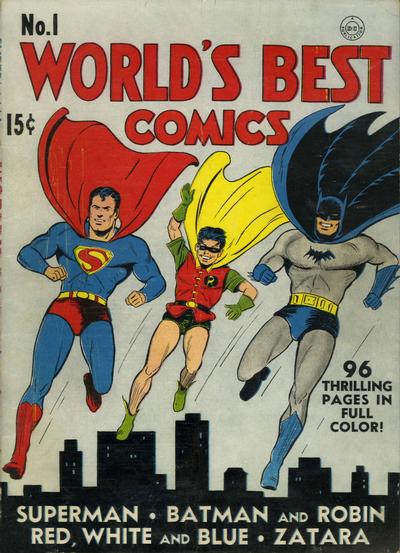
This of course was the first issue of the series that would become known as World’s Finest starting with #2. And the early issues of the comic would feature covers pairing the two (along with Robin, usually) and showing them doing something fun, like, oh, I don’t know, fishing:
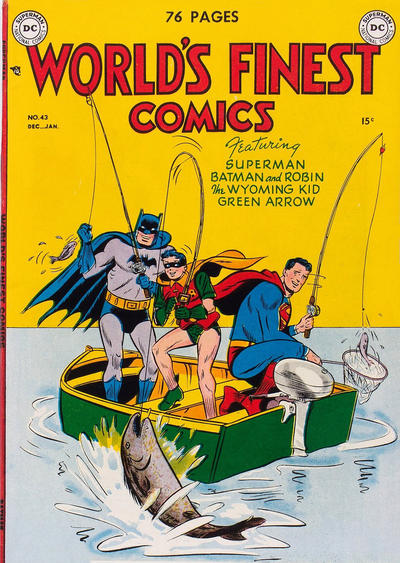
The team-ups were just on the covers, however, as Batman and Superman had separate stories inside, along with other characters and their own stories. Eventually the extra-sized comic reduced its page count, and instead of cutting either Superman or Batman out of the book, the two were squeezed together into one story (starting with issue #71). And aside from a brief stint of team-ups featuring Superman with other characters in the early ’70s, and the whole “Super Sons” thing, this was the Supes/Bats crimefighting pals team book ’til its end in 1986.
Except.
There was a short storyline in this series regarding a split between Batman and Superman, spiraling off from Batman’s resignation from the Justice League in Batman and the Outsiders #1:
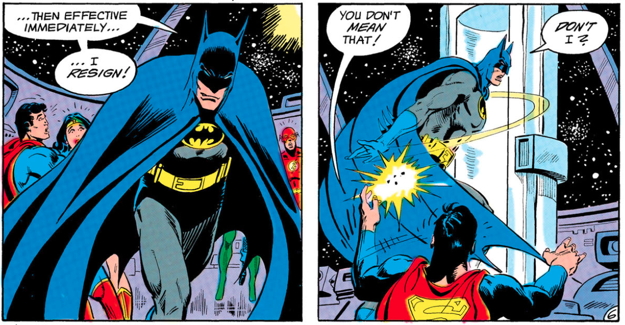
This development gets followed up in World’s Finest #294 (1983) which presents further acrimony between the two old friends:
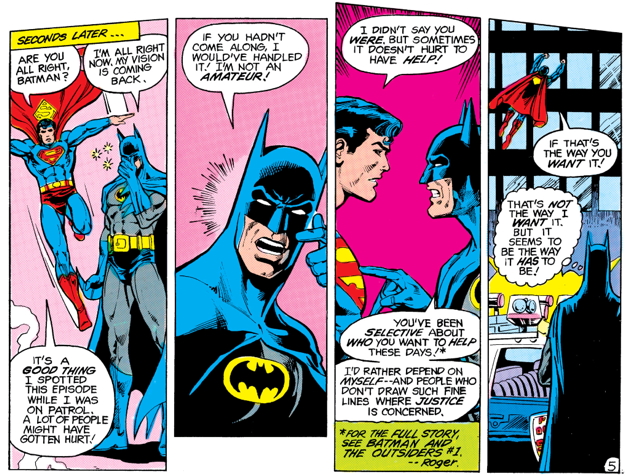
See, it says right there in the footnote, “see Batman and the Outsiders #1,” I didn’t lie to you.
Anyway, the two of them are at odds with each other for the next few issues, until this particular storyline comes to its conclusion at the end of the extra-sized anniversary issue #300 (1984):
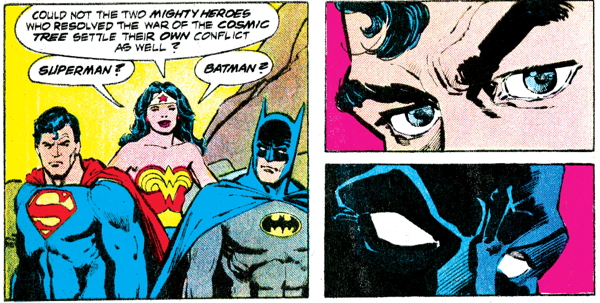
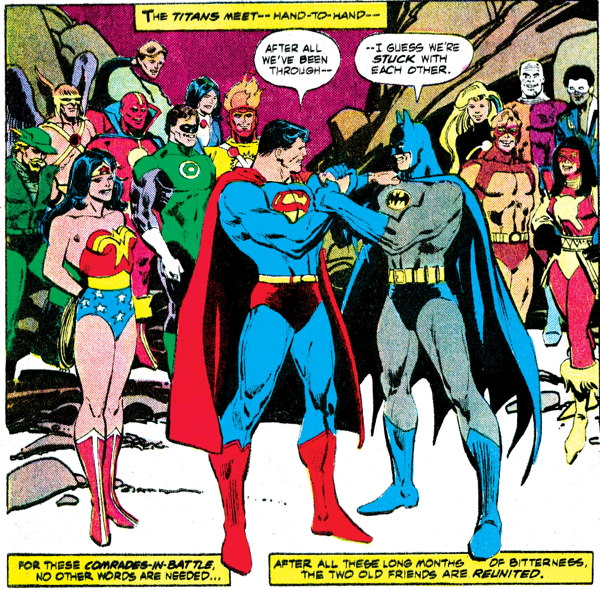
And all was right with the world until 1986, when John Byrne presented his new status quo for the Superman/Batman relationship in Man of Steel #3:
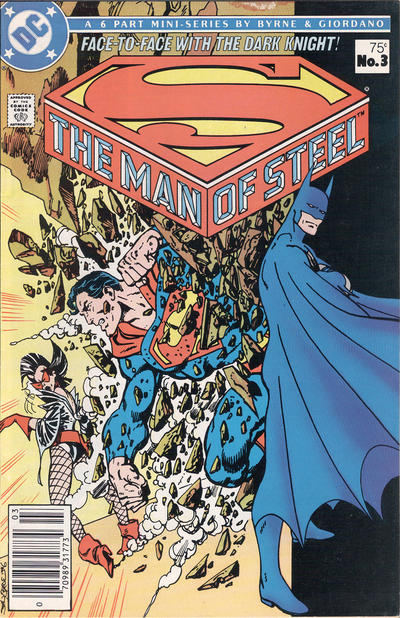
In that preview article from Amazing Heroes #96, Byrne’s ideas on what the relationship between Superman and Batman are made clear:
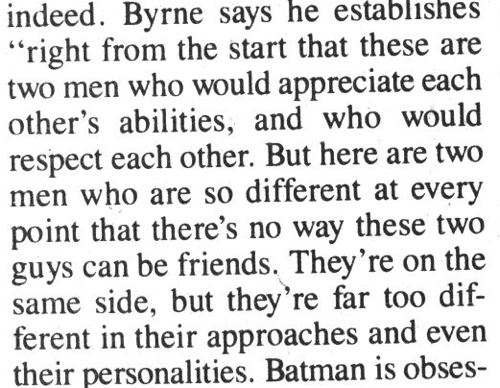
And sure enough, in Man of Steel this new more adversarial interaction is revealed right out of the gate as Superman shows up in Gotham to take in this infamous vigilante:
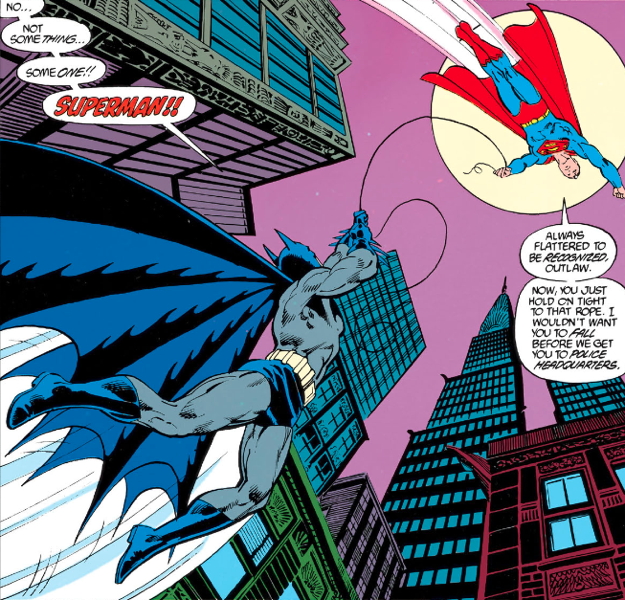
Once Superman sees Batman in action over the course of the story, he softens his stance — i.e. he won’t immediately haul Bats off to the grey-bar hotel — but he’s still not entirely on board:
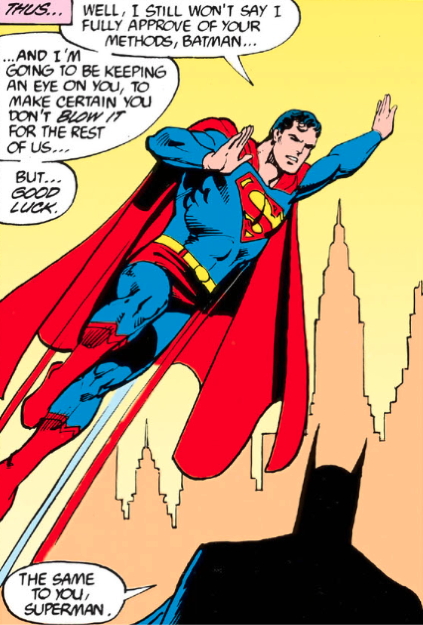
…leaving Batman with this wistful wink to the audience who just saw the Old Ways swept out the door for the Way Things Are Now:
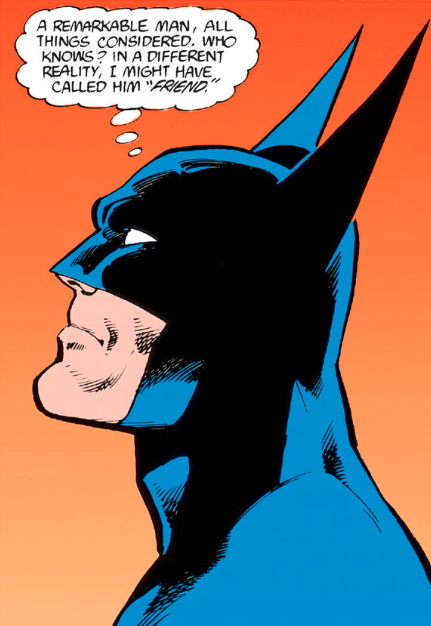
And that was the status quo for…well, a little while, ’til, like all post-Crisis changes, folks started to turn things back to how they were in little ways. The UnCrisis-ening continues to this day, but this particular portrayal of the Superman/Batman relationship, coupled with what we saw between the two in Frank Miller’s Dark Knight Returns, has had a little more staying power.
I mean, obviously not the “you’re a criminal who should be turned in” part, but definitely the emphasis on “our approaches to crimefighting are different” has remained to a far greater extent than it ever did in the older books. It was probably also an influence on Batman’s general gruffness and reluctance to open up to friendships and such in recent years, not to mention the idea of his having contingency plans to take down the whole Justice League, that sort of thing.
However, the Superman/Batman pairing is too strong an idea, with too much inertia behind it, for it to be forever relegated to “frenemies.” We’ve had multiple Superman/Batman team-up mini-series and regular series, certainly with an emphasis on their differences, but definitely having them as pals again. The current World’s Finest absolutely feels more like the original series with that name.
I appreciate Byrne’s point about Superman and Batman just being too different to be friends…but honestly, having them at such odds with each other was the aberration. It’s having them as friends that feels like the correct, logical, choice.
« Older Entries

















































































